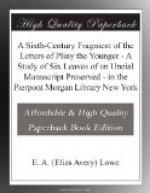[Footnote 2: In an examination of all the uncial manuscripts in the Bibliotheque Nationale of Paris, it was found that out of twenty manuscripts that may be ascribed to the fifth and sixth centuries only two had the hair side on the outside of the quires. Out of thirty written approximately between A.D. 600 and 800, about half showed the same practice, the other half having the hair side outside. Thus the practice of our oldest Latin scribes agrees with that of the Greek: see C.R. Gregory, “Les cahiers des manuscrits grecs” in Comptes Rendus de l’Academie des Inscriptions et Belles-Lettres (1885), p. 261. I am informed by Professor Hyvernat, of the Catholic University of Washington, that the same custom is observed by Coptic scribes.]
[Sidenote: Original size of the manuscript]
In the fifteenth century, as the previous demonstration has made clear, our fragment was preceded by 47 leaves that are missing to-day. With this clue in our possession it can be demonstrated that the manuscript began with the first book of the Letters. We start with the fact that not all the 47 folios (or 94 pages) which preceded our six leaves were devoted to the text of the Letters. For, from the contents of our six leaves we know that each book must have been preceded by an index of addresses and first lines. The indices for Books I and II, if arranged in general like that of Book III, must have occupied four pages.[3] We also learn from our fragment that space must be allowed for a colophon at the end of each book. One page for the colophons of Books I and II is a reasonable allowance. Accordingly it follows that out of the 94 pages preceding our fragment 5 were not devoted to text, or in other words that only 89 pages were thus devoted.
[Footnote 3: The confused arrangement of the indices for Books I and II in the Codex Bellovacensis may well have been found in the manuscript of which the Morgan fragment is a part. The space required for the indices, however, would not have greatly differed from that taken by the index of Book III in both the Morgan fragment and the Codex Bellovacensis.]
Now, if we compare pages in our manuscript with pages of a printed text we find that the average page in our manuscript corresponds to about 19 lines of the Teubner edition of 1912. If we multiply 89 by 19 we get 1691. This number of lines of the size of the Teubner edition should, if our calculation be correct, contain the text of the Letters preceding our fragment. The average page of the Teubner edition of 1912 of the part which interests us contains a little over 29 lines. If we divide 1691 by 29 we get 58.3. Just 58 pages of Teubner text are occupied by the 47 leaves which preceded our fragment. So close a conformity is sufficient to prove our point. We have possibly allowed too much space for indices and colophons, especially if the former covered less ground for Books I and II than for Book III. Further, owing to the abbreviation of que and bus, and particularly of official titles, we can not expect a closer agreement.




